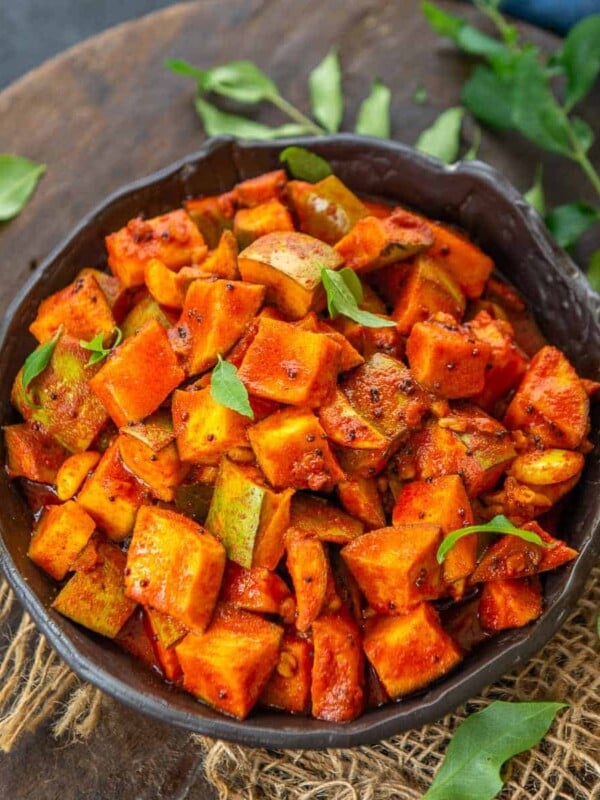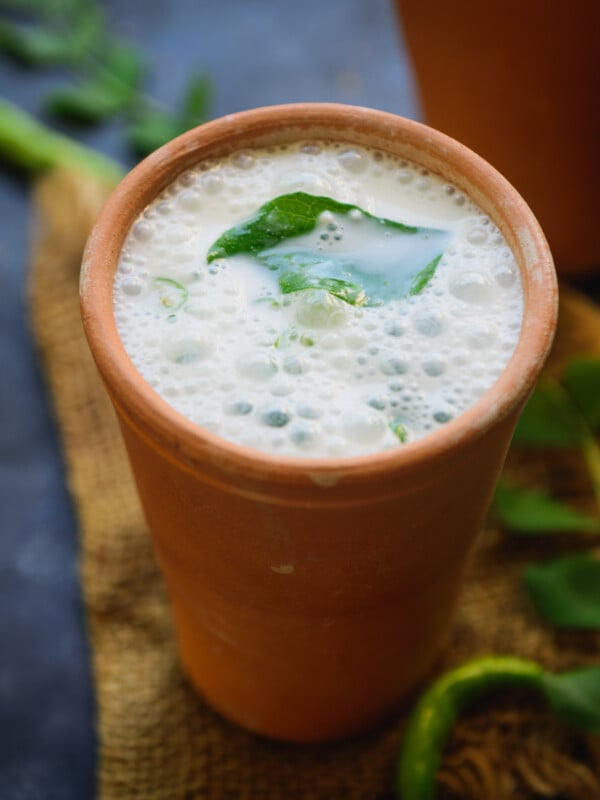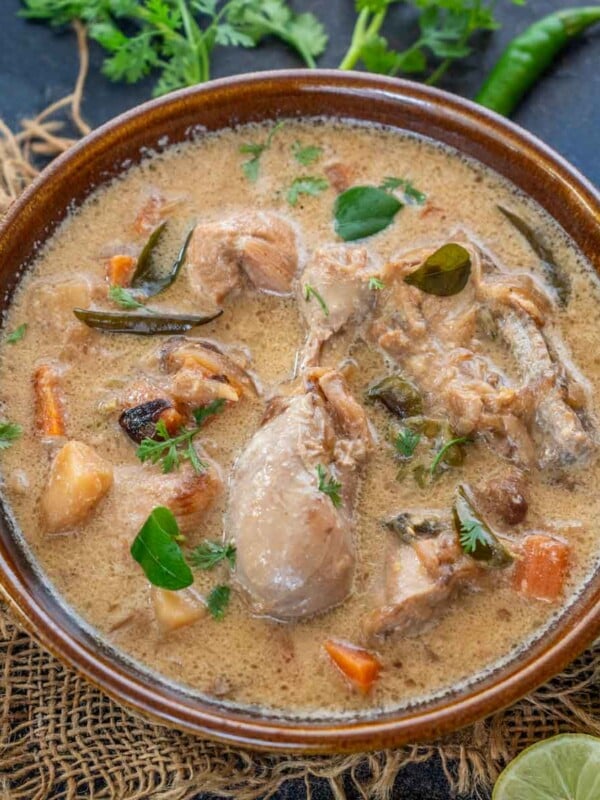Kadala Curry
on Jan 29, 2025, Updated May 21, 2025
Kadala Curry (Kerala-Style Brown Chickpeas Kari) is a quintessential dish in every Malayalee household. It’s very popular to serve with puttu, appam, and dosa for breakfast and with idiyappam or string hoppers, paratha, and boiled red rice for lunch or dinner.
Here are some more brown chickpea recipes: Jaisalmeri Chana, Sookha Kala Chana, and North Indian Style Kala Chana Curry.

Brown chickpeas are a great source of vegetarian protein, and I frequently include them in my diet. This Kerala-style brown chickpea curry is one of my favorites. I like the coconutty curry, which has robust spices and a slight bite from the chickpeas. This curry needs a little pre-planning, as you must soak the chickpeas overnight. Other than that, it’s very easy to make.
About Kadala Curry
Kadala Curry (Kerala Style Brown Chickpeas Kari) is a spicy, flavorful, coconutty brown chickpeas curry made in most Malayalee homes.
This curry from Kerala cuisine is best served for breakfast with puttu, dosa, appam, idli, or idiyappam, or a hearty lunch with steamed matta rice, poori, paratha, or roti.
Each household has its way of making kadala curry. Some make it semi-dry, and some with gravy. It can be made with or without coconut or even using coconut milk. I have mentioned some variations of this kadala curry in the post below. You can try them as well.
I learned this Kerala-style kadala curry recipe from a houseboat owner on one of my trips to Kerala. He served a hearty breakfast of puttu kadala curry, the flavors of which are still etched in my memory. I promise it’s delicious.
Ingredients
Brown Chickpeas (Kala Chana, Brown Chana) – Try to buy organic brown chickpeas.
Whole Spices – For warm flavors, add green cardamoms (hari elaichi), cinnamon (dalchini), and cloves (laung) to the curry.
Fresh Coconut – To save time, buy grated coconut. It is available in the freezer section of any Indian grocery store.
Curry Leaves add a beautiful South Indian touch to the kadala kari, so make sure you use fresh, aromatic ones.
Coconut Oil – This spicy gravy is traditionally made using coconut oil, but you can replace it with any other oil or ghee if it’s unavailable.
Spice Powders – To enhance the taste of the curry, you will need basic spices such as coriander powder, turmeric powder, Kashmiri red chilli powder, and garam masala spice mix.
For a very authentic taste, use my Kerala style garam masala in this recipe. You can also add some black pepper powder for a spicy kick.
Others – You will also need shallots, salt, brown mustard seeds, fennel seeds (saunf), fenugreek seeds (methi dana), curry leaves, ginger garlic paste, onions, tomatoes, and green chillies.
Adjust the green chilies as per your taste.
If shallots are unavailable, then you can use sliced onions in their place.
For The Tempering – To temper the spicy kadala curry, you will need coconut oil, brown mustard seeds, asafetida (hing), curry leaves, and whole dry red chilies.
Tempering is optional, but it adds great flavor to the curry.
How To Make Kerala Kadala Curry
Cook The Chickpeas
Wash 1 cup of dry brown chickpeas with water and soak it in 3 cups of water for 6-8 hours.
Drain the water and wash the chickpeas once again.

Add the soaked chana to an instant pot along with the following ingredients.
- 1 and ½ cups of water
- ½ teaspoon turmeric powder
- 2 teaspoon salt
- 2 green cardamoms
- 1-inch piece of cinnamon stick
- 3-4 cloves

Close the lid and set the valve to the sealing position.

Press PRESSURE COOK and set the timer for 15 minutes at high pressure.
Once the timer goes off, do a 10-minute natural pressure release. Then, release the remaining pressure manually and open the lid. Keep the cooked chickpeas aside.
Note – To cook the chickpeas in a traditional stovetop pressure cooker, cook for one whistle on high heat. Then, reduce the heat to low and cook for 15 minutes. Remove the cooker from the heat and let the pressure release naturally. Open the lid of the cooker.

Make The Coconut Paste
Add ½ cup of grated fresh coconut to a skillet and dry roast on medium heat until lightly browned (3-4 minutes), stirring frequently.

Add ¼ cup of peeled shallots and 10-12 curry leaves and roast until the coconut is nicely browned.
This process gives a very robust flavor to this curry and a very nice color, too.

Add the roasted ingredients to a blender jar along with ¼ cup of water and blend to make a fine paste. Scrape the sides of the jar a few times while blending.
Set the paste aside.


Make The Curry
Heat 4 tablespoon coconut oil in a large pan over medium-high heat.
Add the following ingredients once the oil is hot, and saute for 10-12 seconds.
- ½ teaspoon brown mustard seeds
- 1 teaspoon fennel seeds
- ¼ teaspoon fenugreek seeds
- 10-12 curry leaves
- 2 teaspoon ginger garlic paste

Add ½ cup chopped onions and cook until it turns translucent (3-4 minutes), stirring frequently.

Now add ½ cup chopped tomatoes and 2-3 slit green chilies and cook for another 3-4 minutes. Stir frequently while cooking.

Add the following spice powders and cook for a minute.
- 1 teaspoon coriander powder
- ½ teaspoon turmeric powder
- 1 teaspoon Kashmiri red chili powder
- ½ teaspoon garam masala powder
Add some water if the masala is drying out.

Now add the ground coconut paste that you made earlier and mix well.

Add the cooked brown chana along with the water in which it was cooked to the pan.

Reduce the heat to low.
Cook the curry for 10-12 minutes. Mash a few chana with the back of the ladle to make the gravy creamier.
Add some more water if the curry is too thick.
Check for salt and add more if needed.

Temper The Curry
Heat 2 tablespoon coconut oil in a small skillet over medium-high heat.
Once the oil is hot, add the following ingredients and fry for 4-5 seconds.
- ½ teaspoon brown mustard seeds
- ¼ teaspoon asafetida
- 10-12 curry leaves
- 2-3 whole dry red chilies

Pour the tempering over the curry and stir gently. Serve hot.

Pro Tips By Neha
If you forget to soak the chickpeas, soak them in boiling water for 2 to 3 hours before cooking.
You can cook the chickpeas and store them in the fridge a day before if you plan to cook in the morning. Finishing this step helps to make the curry in less time.
You can adjust the consistency of curry by adding more or less water. If you like it thick, add less water, and vice versa.
You can replace brown chickpeas with white chickpeas for a taste change.
Frequently Asked Questions
To make this curry without coconut, you can follow the same process as mentioned in the recipe but skip adding the coconut. The dish comes out quite good without coconut as well, and you have a different version, too.
To make the kadala curry with coconut milk, skip adding the roasted coconut to the recipe mentioned below. Instead, add thick coconut milk to the ready curry and gently simmer it. Serve hot.
Storage Suggestions
This curry can be stored in the refrigerator in an airtight container for 3-4 days. Reheat in a pan or microwave before serving. If the curry has thickened too much after refrigeration, add some hot water before reheating.
You can also freeze it for up to a month. Thaw, reheat, and serve.
You Might Also Like

Kadala Curry Recipe
Ingredients
To Cook The Chickpeas
- 1 cup dry brown chickpeas (kala chana)
- ½ teaspon turmeric powder
- 2 teaspoons salt
- 2 green cardamoms (hari elaichi)
- 1 inch piece of cinnamon stick (dalchini)
- 3-4 cloves (laung)
For Coconut Paste
- ½ cup grated fresh coconut
- ¼ cup peeled shallots
- 10-12 curry leaves
For The Curry
- 4 tablespoons coconut oil
- ½ teaspoon brown mustard seeds
- 1 teaspoon fennel seeds (saunf)
- ¼ teaspoon fenugreek seeds (methi dana)
- 10-12 curry leaves
- 2 teaspoons ginger garlic paste
- ½ cup chopped onions
- ½ cup chopped tomatoes
- 2-3 green chilies (slit into half)
- 1 teaspoon coriander powder
- ½ teaspoon turmeric powder
- 1 teaspoon Kashmiri red chili powder
- ½ teaspoon garam masala powder
- salt (to taste)
For Tempering
- 2 tablespoons coconut oil
- ½ teaspoon brown mustard seeds
- ¼ teaspoon asafetida (hing) (skip for gluten-free)
- 10-12 curry leaves
- 2-3 whole dry red chilies (stalks removed)
Instructions
Cook The Chickpeas
- Wash chickpeas with water and soak them in 3 cups of water for 6-8 hours.
- Drain the water and wash the chickpeas once again.
- Add the soaked chana to a pressure cooker along with 1 and ½ cups of water, turmeric powder, salt, green cardamoms, cinnamon stick, and cloves, and stir gently.
- Close the lid and set the valve to the sealing position.
- Press PRESSURE COOK and set the timer for 15 minutes at high pressure.
- Once the timer goes off, do a 10 minutes natural pressure release. Then release the remaining pressure manually and open the lid.
- Note – To cook the chickpeas in a traditional stovetop pressure cooker, cook for one whistle on high heat. Then, reduce the heat to low and cook for 15 minutes. Remove the cooker from the heat and let the pressure release naturally. Open the lid of the cooker.
Make The Coconut Paste
- Add coconut to a skillet and roast on medium heat until is it lightly browned (3-4 minutes), stirring frequently.
- Add shallots and curry leaves and roast until the coconut is nicely browned.
- This process gives a very robust flavor to this curry and a very nice color too.
- Once the coconut is roasted, add it to a blender jar along with ¼ cup of water and blend to make a smooth paste. Scrape the sides of the jar a few times while blending.
- Set the paste aside.
Make The Curry
- Heat coconut oil in a large pan over medium-high heat.
- Once the oil is hot, add mustard seeds, fennel seeds, fenugreek seeds, curry leaves, and, ginger garlic paste and saute for 10-12 seconds.
- Add onions and cook until it turns translucent (3-4 minutes), stirring frequently.
- Now add tomatoes and green chilies and cook for another 3-4 minutes. Stir frequently while cooking.
- Add coriander powder, turmeric powder, Kashmiri red chili powder, and garam masala powder, and cook for 1 minute.
- Add some water if the masala is drying out.
- Now add the coconut paste that you made earlier and mix well.
- Add the cooked chana along with the water in which it was cooked to the pan.
- Reduce the heat to low.
- Cook the curry for 10-12 minutes. Mash a few chana with the back of the ladle to make the gravy creamier.
- Add some more water if the curry is too thick.
- Check for salt and add more if needed.
Temper The Curry
- Heat coconut oil in a small skillet over medium-high heat.
- Once the oil is hot, add mustard seeds, asafetida, curry leaves, and dry red chilies, and fry for 4-5 seconds.
- Pour the tempering over the curry and stir gently. Serve hot.























This recipe is delicious. Used whatever garam masala I had and added a cup of coconut milk. Turned out great! Thank you Neha.
Happy to hear 🙂
It turned out really nice…
Happy to hear 🙂
Great recipe! I was searching everywhere for the nutrition facts of kadala curry. Glad that you included it
🙂
Came out really well. Thank you
Happy to hear 🙂
I tried it
It was soooo tasty and nice
Thnx for trying.
I have tried many different recipes for Kadala curry that I found online, but, nothing comes close to your’s. Authentic കേരളീയ സ്വാദ്!
This looks so tasty!
Thnx 🙂
I am going to try these recipes.
I have cooked Indian food but not Kerala Style. I did eat Kerala food from friends and found the style delectable
Do try and me know how it turned out 🙂